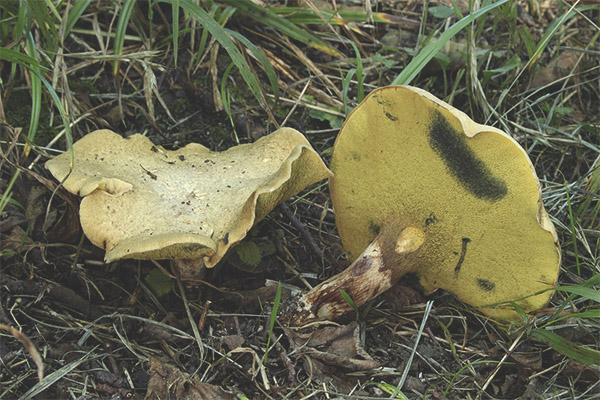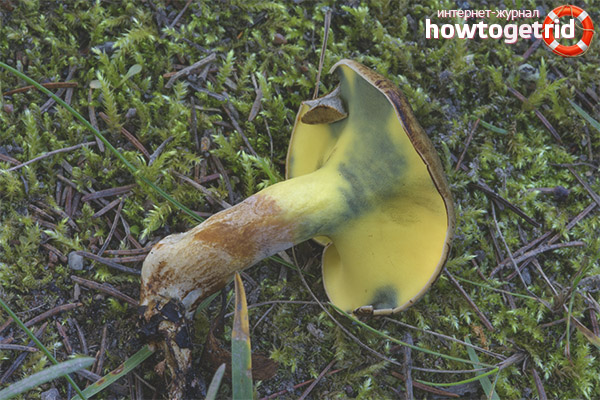The content of the article
A true mushroom picker knows how pleasant it is to go for a walk through the forest in warm weather with the onset of the mushroom season, setting off for a quiet mushroom hunt. If the season is successful, then what kind of mushrooms just can not be found in the forest. Large and small, of different colors and shapes, they are all equally interesting for a real mushroom picker. In the mushroom kingdom there are many representatives who are well known even to beginner mushroom pickers. For example, almost everyone knows what a cep or boletus is. But it is safe to say that the underside is familiar to not every mushroom picker. Therefore, it’s probably time to get to know him better.
general description
In Latin, its name sounds like Gyrodon invidus, the name is beautiful, but is this the mushroom itself? It refers to rarely found edible mushrooms. He is part of the Svinushkovye family.
Where is growing?
For its growth selects the place where the wet soil with an abundance of moss. It must be said that the period during which the fungus bears fruit is not limited to strict limits. The start of this period is the middle of summer, and it ends its fruiting in the first months of autumn. The name of the fungus was given by its ability to enter into a mycorrhizal connection with alder.
Poisonous or not?
It is quite edible mushroom, although it does not have wide popularity. Not many people know about him. This circumstance is not accidental, since the mushroom does not have sufficient nutritional value. It is rarely used for food, hence its modest role in the popularity rating.
What does it look like?
The cap of the fungus has an uneven wavy surface. In the direction from the center to the edges there is a marked narrowing.If you try to touch the surface of the cap, you can note pronounced dryness. During periods of rainy weather, the surface becomes sticky. The cap is colored yellow with the presence of brown shades. The diameter can reach 20 cm, but usually differs by more modest indicators.
The inner surface of the cap is represented by a thin spongy layer. It is characterized by the fact that after touching it turns blue. Then the coloring takes on a brown character. With growth, the shape and character of the pores changes. At first they look like labyrinths, and over time they take on an angular character. The spongy layer has a yellowish color. The mushroom has a flat leg, the color of which is identical to the cap. In height, the stem can reach 7 cm. If the cap is characterized by the presence of fleshy pulp, then in the stem it is of dense nature, with distinct fibers and is colored yellowish.
For the dispute is characterized by a rounded shape. The spore powder is buff brown.
The fungus is a typical tubular hymenophore. As the name implies, he likes to be in the place where the alder grows, namely, under it.
How to use?
This mushroom is consumed in food only fresh, of course, after a thorough heat treatment. Harvest alder in the winter, as it is, to dry, pickle or pickle can not. Used exclusively at a young age.
It is characteristic that this representative has no similarities with poisonous mushrooms. In some countries of Europe it is entered in the Red Book and is under state protection.
It must be said that in the Svushkov family this mushroom is not the only representative. It also drives many other mushrooms. For example, hirudon is peacelis. This species is included in the group of conditionally edible mushrooms. The cap is 12.5 cm in diameter. In a young mushroom, the cap is slightly convex, the edges are tucked. Over time, it takes the form of a funnel. The cap is characterized by the presence of a smooth surface. Color red-brown or yellowish-brown shades. The flesh of the cap has a pronounced density, has a yellow color. She has virtually no taste and smell. For tubes characterized by a dark yellow color. If they are damaged, their color becomes blue-green.
The leg can grow in length up to 5 cm.It has an eccentric shape with different colors in different parts. At the top, it has a dark yellow color, and closer down the color becomes brown or even black. For the fungus is characterized by group growth. Of course, single specimens can occur, but this is extremely rare. The beginning of the period of fruiting is summer and it ends only by mid-autumn.












To send